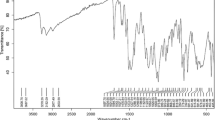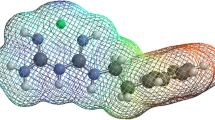Abstract—The effects of acetylating and deacetylating compounds on the activity of succinate dehydrogenase, as well as on the membrane potential and calcium retention capacity of the isolated liver mitochondria, supported by the oxidation of succinate, has been investigated. The chemical reagent N-acetylimidazole, the microbial metabolite phenylacetate, along with the drugs acetylsalicylic acid and N-acetylcysteine, were used as acetylating compounds. These compounds reduced succinate dehydrogenase activity to different extents depending on the concentration and incubation conditions. An inhibitory analysis using intermediate electron carriers has shown that the ubiquinone-binding site of the enzyme undergoes acetylation. The inhibition was partially eliminated or prevented by pre-incubation of the mitochondria with nicotinamide adenine dinucleotide, a co-factor for deacetylation, and with polyamine spermidine, an acceptor of acetyl groups.





Similar content being viewed by others
REFERENCES
K. J. Menzies, H. Zhang, E. Katsyuba, et al., Nat. Rev. Endocrinol. 12 (1), 43 (2016).
W. G. Kaelin, Jr. and S.L. McKnight, Cell 153 (1), 56 (2013).
C. Carrico, J. G. Meyer, W. He, et al., Cell Metab. 27 (3), 497 (2018).
G. R. Wagner and R. M. Payne, J. Aging Res. (2011). doi 10.4061/2011/234875
S. C. Kim, R. Sprung, Y. Chen, et al., Mol. Cell 23 (18), 607 (2006).
L. M. Britton, A. Newhart, N. V. Bhanu, et al., Epigenetics 8 (10), 1101 (2013).
A. M. James, K. Hoogewijs, A. Logan, et al., Cell Rep. 18 (9), 2105 (2017).
J. Baeza, M. J. Smallegan, and J. M. Denu, Trends Biochem. Sci. 41 (3), 231 (2016).
E. Verdin, M. D. Hirschey, L. W. Finley, et al., Trends Biochem. Sci. 35 (12), 669 (2010).
A. S. Olia, K. Barker, C. E. McCullough, et al., ACS Chem. Biol. 10 (9), 2034 (2015). http://www.ncbi.nlm.nih.gov/pubmed/26083674.
G. R. Wagner and M. D. Hirschey, Mol. Cell. 54 (1), 5 (2014).
G. R. Wagner and R. M. Payne, J. Biol. Chem. 288 (40), 29036 (2013).
E. V. Grishina, M. Kh. Galimova, et al., Biol. Membrany 32 (5–6), 319 (2015).
L. W. Finley, W. Haas, V. Desquiret-Dumas, et al., PLoS One 6 (8), e23295 (2011)
H. Cimen, M. J. Han, Y. Yang, et al., Biochemistry 49, 304 (2010).
J. Fernandes, A. Weddle, C. S. Kinter, et al., Biochemistry 54 (25), 4008 (2015).
M. Waldecker, T. Kautenburger, H. Daumann, et al., J. Nutr. Biochem. 19 (9), 587 (2008).
H. Zhang, M. Du, Q. Yang, et al., J. Nutr. Biochem. 27, 299 (2016).
J. Sun, Q. Wu, H. Sun, et al., Int. J. Mol. Sci. 15 (11), 21069 (2014).
M. L. Soliman, M. D. Smith, H. M. Houdek, et al., J. Neuroinflammation 9, 51 (2012).
B. T. Weinert, V. Iesmantavicius, S. A. Wagner, et al., Mol. Cell. 51, 265 (2013).
M. L. Kuhn, B. Zemaitaitis, L. I. Hu, et al., PloS One 9, e94816 (2014).
G. D. Cymes, M. M. Iglesias, and C. Wolfenstein-Todel, Int. J. Pept. Prot. Res. 42 (1), 33 (1993).
Y. Nakae and M. Shono, Histochem. J. 18 (4), 169 (1986).
J. M. Argello and J. H. Kaplan, Biochemistry 29 (24), 5775 (1990).
M. H. Tatham, C. Cole, P. Scullion, et al., Mol. Cell Proteomics 16 (2), 310 (2017).
R. Uppala, B. Dudiak, M. E. Beck, et al., Biochem. Biophys. Res. Commun. 482 (2), 346 (2017).
N. I. Fedotcheva, E. G. Litvinova, M. V. Zakharchenko, et al., Biochemistry (Moscow) 82 (2), 192 (2017).
T. A. Fedotcheva, V. V. Teplova, and N. I. Fedotcheva, Biol. Membrany 35 (1), 79 (2018).
L. Guo, A. A. Shestov, A. J. Worth, et al., J. Biol. Chem. 291 (1), 42 (2016).
Y. Zhang, J. Yin, L. Zhang, et al., Neurol. Res. 39 (3), 248 (2017).
S. Mandal, A. Mandal, and M. H. Park, Biochem. J. 468 (3), 435 (2015).
A. C. Nulton-Persson, L. I. Szweda, and H. A. Sadek, J. Cardiovasc. Pharmacol. 44 (5), 591 (2004).
H. Raza, A. John, and S. Benedict, Eur. J. Pharmacol. 668 (1–2), 15 (2011).
T. Tomoda, K. Takeda, T. Kurashige, et al., Liver 14 (2), 103 (1994).
K. W. Oh, T. Qian, D. A. Brenner, et al., Toxicol. Sci. 73 (1), 44 (2003).
X. Wang, A. Shojaie, Y. Zhang, et al., PLoS One 12 (5), e0178444 (2017).
N. I. Fedotcheva, V. V. Teplova, and N. V. Beloborodova, Biochemistry (Moscow) Suppl. Ser. A: Membr. Cell Biol. 4 (1), 50 (2010).
N. I. Fedotcheva, V. V. Teplova, and N. V. Beloborodova, Biophysics (Moscow) 57 (5), 634 (2012).
V. T. Vachharajani, T. Liu, X. Wang, et al., J. Immunol. Res. 6, 8167273 (2016).
T. F. Liu, V. T. Vachharajani, B. K. Yoza, et al., J. Biol. Chem. 287 (31), 25758 (2012).
A. E. Pegg, Am. J. Physiol. Endocrinol. Metab. 294 (6), E995 (2008).
ACKNOWLEDGMENTS
This work was supported by the Russian Foundation for Basic Research, projects no. 16-04-00636 and 16-04-00342, and the Russian Science Foundation, project no. 15-15-00110.
Author information
Authors and Affiliations
Corresponding author
Additional information
Translated by E. Puchkov
Abbreviations: SDH, succinate dehydrogenase; TTFA, thenoyltrifluoroacetate; PMS, phenazine methosulfate; NAD, nicotinamide adenine dinucleotide; DCPIP, dichlorophenolindophenol; MTT, 3-(4,5-dimethylthiazole-2-il)-2,5-diphenyl-tetrazolium bromide.
Rights and permissions
About this article
Cite this article
Fedotcheva, N.I., Kondrashova, M.N., Litvinova, E.G. et al. Modulation of the Activity of Succinate Dehydrogenase by Acetylation with Chemicals, Drugs, and Microbial Metabolites. BIOPHYSICS 63, 743–750 (2018). https://doi.org/10.1134/S0006350918050081
Received:
Published:
Issue Date:
DOI: https://doi.org/10.1134/S0006350918050081




